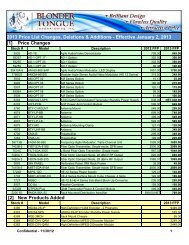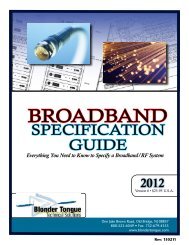Functional Block Diagram - Blonder Tongue Laboratories Inc.
Functional Block Diagram - Blonder Tongue Laboratories Inc.
Functional Block Diagram - Blonder Tongue Laboratories Inc.
Create successful ePaper yourself
Turn your PDF publications into a flip-book with our unique Google optimized e-Paper software.
Broadband Specification Guide<br />
CATV Terms & Definitions<br />
AGC<br />
Abbreviation for Automatic Gain Control. Units with this feature maintain<br />
a constant output level when the input signal level varies within a<br />
specified AGC range.<br />
Agile (Frequency Agile)<br />
The capability to change channels quickly and easily, usually by setting<br />
switches, i.e. agile modulator, agile processor.<br />
Amplifier<br />
Device used to increase strength of TV signals.<br />
Attenuation<br />
Reduction of signal strength.<br />
Attenuator<br />
Device used to receive radiated electro-magnetic signals such as radio<br />
or TV.<br />
Atmosphere<br />
The gaseous envelope surrounding the Earth, composed of 78% nitrogen,<br />
21% oxygen, 0.9% argon, plus some carbon dioxide and water vapor. The<br />
atmosphere is divided into several layers, as follows:<br />
Troposphere: 0-10 miles<br />
Stratosphere: 10-50 miles<br />
Ionosphere: 50-370 miles<br />
Exosphere: 370 + miles<br />
Automatic Gain Control (AGC)<br />
A feature of some amplifiers and radio receivers which provides a<br />
substantially constant output even though the signal input varies over<br />
wide limits.<br />
Automatic Level Control (ALC)<br />
See Automatic gain control.<br />
Automatic Slope Control (ASC)<br />
A circuit that controls the slope of an amplifier automatically. See Slope.<br />
Avalanche Effect<br />
The cumulative multiplication of carriers in a semiconductor caused by<br />
an electric field across the barrier region strong enough so that electrons<br />
collide with valence electrons, releasing new electrons which have more<br />
collisions, which release more electrons, etc.<br />
Avalanche Photodiode (APD)<br />
A photodiode designed to take advantage of avalanche multiplication of<br />
photo-current. As the reverse-bias voltage approaches the breakdown<br />
voltage, hole-electron pairs created by absorbed photons acquire<br />
sufficient energy to create additional hole-electron pairs when they<br />
collide with substrate atoms; thus a multiplication effect is achieved.<br />
Amplification is almost noiseless, and this makes APD's 10 to 15 dB more<br />
sensitive than PIN photodiodes. The problems with APD's are:<br />
temperature sensitivity, high reverse bias voltages (200 to 400 V to<br />
achieve current multiplication of 100), and prices higher than PIN<br />
photodiodes.<br />
Axial Mode<br />
See longitudinal mode.<br />
Axial Ray<br />
A ray passing through the axis of the optical waveguide without any<br />
internal reflection.<br />
Azimuth<br />
Degrees clockwise from true north. For a compass heading a correction<br />
for local magnetic deviation is required.<br />
Azimuth-Elevation Mount<br />
Two pivot system consisting of separate azimuth and elevation<br />
adjustments for aiming a satellite antenna.<br />
Backscattering<br />
The scattering of light in a direction generally reverse to the original one.<br />
Balun<br />
Acronym for Balanced- Unbalanced. Refers to a 75 ohm to 300 OHM<br />
impedance matching transformer.<br />
Bandwidth<br />
1. A range of frequencies (a portion of spectrum) defined by upper and<br />
lower frequency limits.<br />
2. The capacity of an optical fiber to transmit information expressed in<br />
bits of information transmitted in a specific time period for a specific<br />
length of optical waveguide. Usually expressed like 10 megabits/sec/<br />
km. Bandwidth is limited by pulse spreading or broadening due to<br />
dispersion, so that adjacent pulses overlap and cannot be distinguished.<br />
3. The range of frequencies within which a fiber optic waveguide or<br />
terminal device performs at a given specification.<br />
Bandwidth-limited Operation<br />
The condition prevailing when the system bandwidth, rather than the<br />
amplitude (or power) of the signal, limits performance. The condition is<br />
reached when the system distorts the shape of the wave form beyond<br />
specified limits. For linear systems, bandwidth- limited operation is<br />
equivalent to distortion -limited operation.<br />
Beam Splitter<br />
A device that divides an incident beam into two or more separate beams.<br />
Prisms, thin films, sheets of glass, and partially silvered mirrors can be<br />
used to split a beam.<br />
Beat<br />
1. To combine two carriers, so as to produce new sum and difference<br />
frequency carriers.<br />
2. A carrier generated by two or more carriers which have been passed<br />
through a non-linear circuit.<br />
81
















